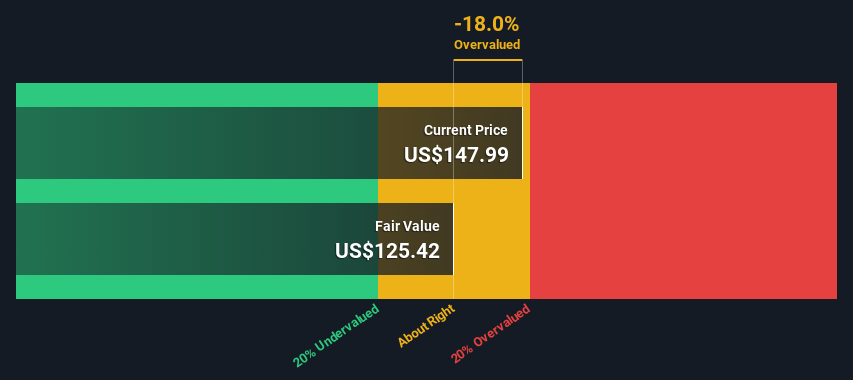- United States
- /
- Consumer Durables
- /
- NYSE:WHR
Calculating The Fair Value Of Whirlpool Corporation (NYSE:WHR)

Key Insights
- Using the 2 Stage Free Cash Flow to Equity, Whirlpool fair value estimate is US$125
- Current share price of US$148 suggests Whirlpool is potentially trading close to its fair value
- The US$148 analyst price target for WHR is 18% more than our estimate of fair value
Today we'll do a simple run through of a valuation method used to estimate the attractiveness of Whirlpool Corporation (NYSE:WHR) as an investment opportunity by taking the forecast future cash flows of the company and discounting them back to today's value. We will use the Discounted Cash Flow (DCF) model on this occasion. Don't get put off by the jargon, the math behind it is actually quite straightforward.
Companies can be valued in a lot of ways, so we would point out that a DCF is not perfect for every situation. If you still have some burning questions about this type of valuation, take a look at the Simply Wall St analysis model.
Check out our latest analysis for Whirlpool
The Calculation
We use what is known as a 2-stage model, which simply means we have two different periods of growth rates for the company's cash flows. Generally the first stage is higher growth, and the second stage is a lower growth phase. To begin with, we have to get estimates of the next ten years of cash flows. Where possible we use analyst estimates, but when these aren't available we extrapolate the previous free cash flow (FCF) from the last estimate or reported value. We assume companies with shrinking free cash flow will slow their rate of shrinkage, and that companies with growing free cash flow will see their growth rate slow, over this period. We do this to reflect that growth tends to slow more in the early years than it does in later years.
Generally we assume that a dollar today is more valuable than a dollar in the future, so we need to discount the sum of these future cash flows to arrive at a present value estimate:
10-year free cash flow (FCF) forecast
| 2023 | 2024 | 2025 | 2026 | 2027 | 2028 | 2029 | 2030 | 2031 | 2032 | |
| Levered FCF ($, Millions) | US$567.2m | US$1.10b | US$832.0m | US$799.0m | US$783.2m | US$777.4m | US$778.2m | US$783.7m | US$792.6m | US$803.8m |
| Growth Rate Estimate Source | Analyst x5 | Analyst x2 | Analyst x1 | Analyst x1 | Est @ -1.97% | Est @ -0.75% | Est @ 0.11% | Est @ 0.71% | Est @ 1.13% | Est @ 1.42% |
| Present Value ($, Millions) Discounted @ 13% | US$504 | US$872 | US$584 | US$498 | US$434 | US$383 | US$341 | US$305 | US$274 | US$247 |
("Est" = FCF growth rate estimated by Simply Wall St)
Present Value of 10-year Cash Flow (PVCF) = US$4.4b
After calculating the present value of future cash flows in the initial 10-year period, we need to calculate the Terminal Value, which accounts for all future cash flows beyond the first stage. The Gordon Growth formula is used to calculate Terminal Value at a future annual growth rate equal to the 5-year average of the 10-year government bond yield of 2.1%. We discount the terminal cash flows to today's value at a cost of equity of 13%.
Terminal Value (TV)= FCF2032 × (1 + g) ÷ (r – g) = US$804m× (1 + 2.1%) ÷ (13%– 2.1%) = US$7.9b
Present Value of Terminal Value (PVTV)= TV / (1 + r)10= US$7.9b÷ ( 1 + 13%)10= US$2.4b
The total value, or equity value, is then the sum of the present value of the future cash flows, which in this case is US$6.9b. To get the intrinsic value per share, we divide this by the total number of shares outstanding. Compared to the current share price of US$148, the company appears around fair value at the time of writing. Remember though, that this is just an approximate valuation, and like any complex formula - garbage in, garbage out.

The Assumptions
The calculation above is very dependent on two assumptions. The first is the discount rate and the other is the cash flows. If you don't agree with these result, have a go at the calculation yourself and play with the assumptions. The DCF also does not consider the possible cyclicality of an industry, or a company's future capital requirements, so it does not give a full picture of a company's potential performance. Given that we are looking at Whirlpool as potential shareholders, the cost of equity is used as the discount rate, rather than the cost of capital (or weighted average cost of capital, WACC) which accounts for debt. In this calculation we've used 13%, which is based on a levered beta of 1.752. Beta is a measure of a stock's volatility, compared to the market as a whole. We get our beta from the industry average beta of globally comparable companies, with an imposed limit between 0.8 and 2.0, which is a reasonable range for a stable business.
SWOT Analysis for Whirlpool
- Debt is well covered by earnings.
- Dividend is low compared to the top 25% of dividend payers in the Consumer Durables market.
- Expected to breakeven next year.
- Has sufficient cash runway for more than 3 years based on current free cash flows.
- Good value based on P/S ratio compared to estimated Fair P/S ratio.
- Debt is not well covered by operating cash flow.
- Paying a dividend but company is unprofitable.
- Revenue is forecast to decrease over the next 2 years.
Looking Ahead:
Whilst important, the DCF calculation shouldn't be the only metric you look at when researching a company. It's not possible to obtain a foolproof valuation with a DCF model. Instead the best use for a DCF model is to test certain assumptions and theories to see if they would lead to the company being undervalued or overvalued. If a company grows at a different rate, or if its cost of equity or risk free rate changes sharply, the output can look very different. For Whirlpool, we've compiled three essential elements you should assess:
- Risks: Case in point, we've spotted 2 warning signs for Whirlpool you should be aware of, and 1 of them can't be ignored.
- Management:Have insiders been ramping up their shares to take advantage of the market's sentiment for WHR's future outlook? Check out our management and board analysis with insights on CEO compensation and governance factors.
- Other High Quality Alternatives: Do you like a good all-rounder? Explore our interactive list of high quality stocks to get an idea of what else is out there you may be missing!
PS. Simply Wall St updates its DCF calculation for every American stock every day, so if you want to find the intrinsic value of any other stock just search here.
Valuation is complex, but we're here to simplify it.
Discover if Whirlpool might be undervalued or overvalued with our detailed analysis, featuring fair value estimates, potential risks, dividends, insider trades, and its financial condition.
Access Free AnalysisHave feedback on this article? Concerned about the content? Get in touch with us directly. Alternatively, email editorial-team (at) simplywallst.com.
This article by Simply Wall St is general in nature. We provide commentary based on historical data and analyst forecasts only using an unbiased methodology and our articles are not intended to be financial advice. It does not constitute a recommendation to buy or sell any stock, and does not take account of your objectives, or your financial situation. We aim to bring you long-term focused analysis driven by fundamental data. Note that our analysis may not factor in the latest price-sensitive company announcements or qualitative material. Simply Wall St has no position in any stocks mentioned.
About NYSE:WHR
Whirlpool
Manufactures and markets home appliances and related products and services in the North America, Europe, the Middle East, Africa, Latin America, and Asia.
6 star dividend payer and good value.

